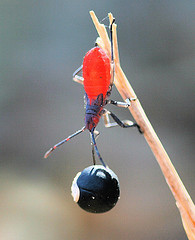Soapberry bugs are beautiful insects that are found in many parts of the world. Their most defining ecological characteristic is their specialized diet. They feed on the seeds of the soapberry family, which includes well known plants like boxelders, maples, soapberries (or soapnuts), jacket plums, rambutans, and litchis. These plants have evolved many ways to protect their seeds from soapberry bugs: flying seeds, seeds protected in inflated spheres, seeds with cyanide, and seeds that are held unfilled on the plant for months while the bugs slowly starve. Yet these insects work around the plants' co-evolved defenses and use the seeds to fuel their own development and reproduction.
With their gorgeous coloration and tendency aggregate by the thousands, soapberry bugs have long caught the attention of people all over the world. Historically, research focused on describing and categorizing individual species based on their morphology. By the mid 20th century, research began to expand outside the realm of taxonomy. The specialization on soapberries was noticed in the 1980s and they were first called soapberry bugs in 1991. Most importantly, studies soon revealed soapberry bugs' fascinatingly varied life histories and spectacular capacity for rapid evolution. Today these insects are study subjects for geneticists, ecologists, animal behaviorists, and evolutionary biologists. They are also a source of both artistic inspiration and residential intimidation. However, they are not serious pests, and they do not breed on litchis and other economically important soapberries.
Soapberry bugs are very approachable native guides to how evolution is taking place on earth today. This web site is a one-stop source about them for curious students of nature from all backgrounds. And importantly for our work, you can help us to advance soapberry bug science by sharing your sightings, observations, and photos with us and the soapberry bug community of professional and citizen scientists.



